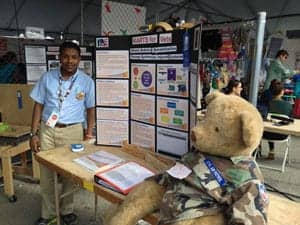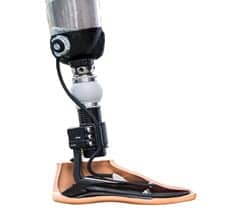
Joseph Anand, (pictured right) a ninth-grader who recently exhibited the Kinect and Arduino Rehab Therapy System (KARTS) for Vets device at the World Maker Faire New York 2013, reports on the Maker Faire’s website that he prototyped the rehabilitation exercise system with the Microsoft Kinect video-gaming sensor and a custom program he wrote.
Anand exhibited the device along with his brother Daniel Anand, aged 12 years old, who also exhibited his own motorized wheelchair transfer device at the Faire.
Anand began working on the device in the spring of 2013 and over the summer, working with a local professor who assisted Anand in the development of the device’s coding. Anand notes that he also did some work on the device during the summer, “to get it to the next level of hardware machinery which I have.”
Anand states in his abstract on the Maker Faire website that the program is designed to issue a doctor-approved exercise regimen requiring the patient to move their limbs to specific angles or exercise ranges of motion, as it times their progress. The device uses the Kinect sensor to detect limb angles, Anand says.
Anand also states in the abstract that if the patient runs out of time or is unable to move the limb fully, the Kinect communicates with an Arduino microcontroller engineered to control a motor attached to the limbs. The Arduino-controlled motor is intended to provide assistance for weak muscles and resistance for strong muscles. The Kinect then verifies the patient is reaching the angle desired and provides feedback.
One of the key ways Anand, who hopes to join the military himself one day, hopes the device will benefit injured veterans is to increase their motivation to engage in the physical therapy exercises designed to make them well. Executing these exercises in a game-format can help bolster this motivation among the veterans, Anand says, “especially with the networking I am looking into doing with the game controller, being able to play against each other [can] keep them motivated.”
“Another big thing would be cost. They would be able to do these at home. The whole system wouldn’t be as expensive,” Anand adds.
Additionally, the device could potentially allow doctors treating these patients to use their time more efficiently. “With the networked version of my machine, they would be able to watch the patients exercising occasionally to make sure that they are doing it right. The patients don’t always have to come in to be seen by the doctor. It could be more of a telemedicine aspect of it,” Anand explains
In his abstract’s conclusion, Anand explains that the program can be customized to accommodate a range of exercises, involving the upper or lower limbs. Anand also notes that the system targets a physical therapy platform that could potentially save money, manpower, and resources while providing patients effective physical therapy exercises.
Anand reports that he has already investigated how the technology may be expanded toward general population uses, particularly for common surgeries such as knee replacement or hip surgeries. Yet, there are a few remaining items he needs to address prior to continuing with the prototype’s development, according to Anand.
This includes forging a partnership with a local hospital to work with, as well as refining the machine itself, “which is good for testing and display purposes, but it needs to have a little more hardware changes to make it more user-friendly and make it also a little more manufacture-able.”
Anand adds that he will also aim to make the software more game-like, more engaging, and to develop the user interface.
To learn more about the Maker Faire New York 2013 and other Maker exhibits, click here.
[Photo Credit: Maker Faire]
[Source(s): Maker Faire website, Joseph Anand]




